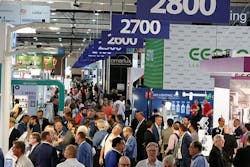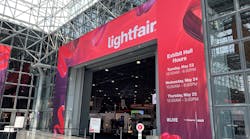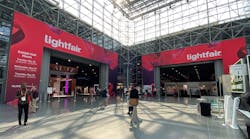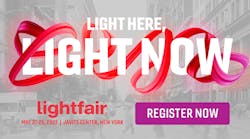Lightfair International brought together nearly 28,000 industry participants from April 27-29 at the San Diego Convention Center to demonstrate how lighting can reshape the energy ecosystem, altering its production, distribution, and management, thus opening the way for Moore’s Law and Haitz’s Law to more fully merge computation power (sensing and analytics) and photon creation (light) at the “connected socket.” According to the show’s organizers, this was the largest trade show in its 27-year history, featuring 617 exhibitors.
Related
Internet of Things
As seen on the exhibit floor and in its newly offered IoT and Smart Lighting Forum, the convergence of the Internet of Things (IoT) and LED light sources continues to hasten the delivery of new products/ideas to the electrical industry. The IoT simplifies the collection of environmental information, such as energy use, for analysis and action (Lighting as a Service), effectively joining the “Enernet” with the Internet. Similarly, connected lighting systems that report the amount of energy being used allow a building owner to enroll in a pay-for-performance program. Essentially, the industry is moving to an information technology (IT)-like system approach to lighting, and manufacturers are seeking out specific niches for growth, such as human performance/production or building management.
The coin-sized sensors and networks connected to these semiconductor light sources are poised to become much more valuable than illumination itself. Michael Poplawski, senior engineer at the Pacific Northwest National Laboratory, notes that people are trying to think of a segment that LEDs won’t dominate.
What's new
Five trends were identified at this year’s show.
1) Gains in lumens per watt (lm/W) efficiency allows for an improvement in an existing lighting design, and a source with a higher lumen output and a smaller heat sink in the fixture to be specified. For example, Cree second-generation CXA high-density chip-on-board (COB) KED family offers a 40% improvement over its previous version. The company also promoted a performance upgrade for its XP-L and XP-G2 product lines. Moreover, Lumileds showcased an addition to its existing 3535L family, which offers an efficiency approaching 200 lm/W.
2) Delivery of low-voltage power over Class II conductors to serve LED luminaires while reducing energy consumption and materials cost. Because LED light sources are inherently low-voltage devices, avoiding the conversion from AC power offers a variety of advantages. Eaton demonstrated its distributed low-voltage power (DLVP) architecture for ceiling-mounted luminaires, which will carry the DC power and data over low-voltage cables. The company’s intent is to create a standard and have other manufacturers take advantage of the DLVP architecture.
At the same time, the EMerge Alliance showed its DC power distribution system employing a DC bus that attaches to a suspended ceiling grid, with power provided by Nextek and control provided by a wireless network.
Nevertheless, the Power over Ethernet (PoE) scheme garnered the most attention, with switch maker Cisco promoting its Digital Ceiling framework along with Philips, Acuity, Cree, Eaton, and other firms that are on board. With LED lights connected to an Ethernet network and deploying visual light communications (VLC), Cree’s SmartCast PoE allows users to preconfigure their lighting preferences so that the lights adjust when they walk into a room.
The standard for low-voltage lighting systems (UL2108) was revised in 2015 to accommodate PoE lighting systems. These systems include a network switch serving as the LED driver, communications cable (Cat. 5/Cat. 6), and luminaires with an RJ45 port to connect to the network switch.
3) Simplification of controls for both wireless and wired lighting systems. Controls that integrate addressable lighting systems with software control can work with wall stations, web-based software, VOIP telephones or mobile devices (such as an iPhone), Bluetooth connection, or a ZigBee-based network. Several solutions were demonstrated on the show floor.
Hubbell Control Solutions’ NX Fixture Controller includes an astronomical time clock for stand-alone operation, or a Bluetooth wireless network function with 0V to 10V dimming, and a variety of sensing devices. An optional current sensor can record energy consumption and fixture temperature, and programming can be done via a smart phone or tablet. The Audacy Lighting Control System from Ideal Industries is designed for easy set-up in commercial office spaces and other locations. Xeleum’s Xi-Fi wireless network now works with high-bay lighting systems. Digital Lumens displayed the CLE industrial fixture family, which can be joined to its Light Rules control system for progressive dimming and daylight harvesting and to collect a variety of operational data for detailed reporting. Lutron’s Vive wireless platform can cover 10,000 ft2 and connect to as many as 700 devices, controlling LED-based lighting, other loads, and sensors, as well as integrate with a larger control system. Intended as a management interface for a PC or smartphone device, the Vive Wireless Hub acts as a Wi-Fi router device; it can also link to the company’s proprietary Clear Connect wireless network, to an Ethernet interface, or a utility demand response system. Vive adds 2-way communications, enabling the reporting of power usage and flexibility in plug-load control. Lutron also showcased its line of home control platforms, such as the Caseta Wireless system for homes, which is compatible with third-party devices linked to the company’s app.
4) Dim-to-warm capabilities, tunable white lighting, which allows the color temperature of the light source to vary from 2,200K to 5,500K, and specialized color production were well represented on the exhibit floor. WattStopper Legrand, Acuity Brands, Philips and Lighting Science, Inc. were among the many companies showing time-of-day color changes that assist the human circadian function. Eaton’s Cooper Lighting offers its D2W warm dimming and color-tuning.
5) The integration of lighting with building systems, centralized management and supervision, as well as interoperability with other systems was also on display. Acuity offers broad building connectivity by linking their LED network with HVAC control, based on the recent purchase of Distech Controls, and the company maintains one of largest array of control offerings. In addition, Samsung displayed its Smart Lighting Module for lighting manufacturers to imbed in LED luminaires and link them to the Internet. Stack Lighting provides sensors and drivers along with digital signal processing technology that go into LED light sources and luminaires to achieve cloud-based data analytics. Lunera Lighting places Stack devices into its light sources, allowing communication with a building’s data network through ZigBee wireless connectivity. Nanoleaf and several other firms also showed how to integrate lighting with building controls.
SIDEBAR: LFI Innovation Award Winners
This annual awards program highlights the industry’s most innovative products and designs introduced during the last 12 months. This year’s competition reeled in 275 entries spanning 15 categories. Each submission was judged by an independent panel of lighting professionals. Winning entries exemplified the best in innovative design and thinking.
Here are the key awards that were presented at this year’s event.
Most Innovative Product of the Year — Philips’ Gardco SoftView LED Parking Garage Luminaire. This is the program’s highest award, recognizing the most innovative new product.
Design Excellence — ADOT Lighting Co., Ltd.’s Rayee bent shape task light.
Technical Innovation — DMF Lighting’s OneFrame recessed LED downlight. This category recognizes the most forward-thinking advancement in lighting technology.
Judges' Citation — Eaton’s ATON Invue Arbor outdoor architectural LED collection. This award gives special recognition of an innovative product at the judges’ discretion.
Visit http://www.lightfair.com/lightfair/V40/index.cvn?id=10219 for a full list of entrants and winners.




